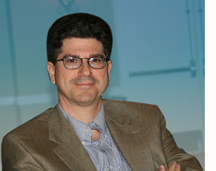

LIDS Alumni Daniel Grunberg jokes that his career is the result of “not ever being able to do the same thing for very long.” The dark-haired engineer and entrepreneur has worked with industrial controls and image processing, co-founded companies, and even pioneered advances in accounting software. Although he’s often shifted focus, he’s never been without a love of engineering or the values and associations he formed at LIDS.
Dan has few illusions about how he landed in graduate school. When he finished his bachelor’s degree in electrical engineering in 1983, the economy was in a recession. So rather than elbow his way into a tough job market, he decided to continue on an academic path. He joined LIDS, where he could keep working with his undergraduate advisor, Michael Athans, studying non-linear control theory.
After obtaining his PhD, Dan started his career by building on the relationship he’d formed with his advisor and current LIDS director Alan Willsky, and for a few years he worked as a researcher in their company. But it wasn’t long before intellectual wanderlust set in and Dan left to start on a project of his own for Jackson Hewitt. At the time, the company was making an early attempt at creating tax preparation software, and Dan pulled together a group of MIT colleagues to write a computerized tax preparation system that turned Jackson Hewitt into a major competitor in the field. This system was one of the first to feature a dialog interface—where the preparer is asked to answer specific questions, instead of filling out spreadsheets.
Dan was promoted to Vice President of Technology, but he left after “the innovation and exciting stuff had been done.” A few years later, he hit upon a formula that satisfied him for a while—Dan formed Chainwave—a one-man consulting firm that he managed while simultaneously working on the board of Boston-based venture capital organization Common Angels.
In this position, Dan had the opportunity to tackle new problems all the time, moving from one challenge to the next. He worked in industrial control, programming schedules for electroplating robots. He created educational software that allowed students to print and cut out shapes that could be taped together to make geometric figures. He solved sensor problems. Everything intrigued him.
“I found that for virtually anything that you do—if you want to do a good job—you get very interested in it,” says Dan, “There’s a lot of innovation that you can do, even to what you think is a very mundane thing.”
Most recently, Dan cofounded a new company, once again collaborating with a number of colleagues from MIT. Together they’re investigating image compression technologies for distributing video over the Internet.
What Dan describes in jest as a handicap—his need to seek out the next interesting problem—has led to a dynamic career. He’s constantly tackling new subjects, and out of necessity he’s learned to become an expert on any given topic in his field in short order. That skill seems to come from two parts training, one part passion.
“Take a lot of mathematics,” says Dan, repeating the advice he heard so often from his own advisor, “[Math] is really hard to learn on your own, if you don’t have a certain level of mathematical maturity. The beginning parts have to be learned at school, in a classroom, with a professor to prepare you. After that you can learn on your own.”
Now, Dan says, he can easily pick up a book and learn about, for example, prime number theory. He has mathematical maturity—a characteristic born of a critical mass of mathematical experience.
Although he’s grown adept at teaching himself, Dan admits that it’s rarely necessary to understand every detail. Instead, he uses systems thinking—in which you draw a black box around some parts of the system, and focus on just the inputs and outputs to understand the shape of the problem.
A portion of his success must be attributed simply to his affinity for engineering. “I guess I was what you might call a tinkerer, growing up,” says Dan. He has loved science and engineering for as long as he can remember, but he hasn’t always differentiated between the two. In fact, Dan made it through nearly three years of college as physics major before he discovered his preference for engineering.
“I was in my junior year and I realized I really wasn’t happy with the physics courses. But I loved the engineering courses and... it was just a lot more interesting. I switched and I never looked back, and that’s not to say that physics is bad and engineering is good, but for me... I was an engineer and not a scientist.”
When asked to distinguish between science and engineering, Dan replies with a quote that he heard in one of first engineering courses at MIT. The phrase comes from Hungarian-American engineer Theodore von Kármán:
“Scientists study that which is, engineers create that which has never been.” Engineering, Dan explains, has always been “building stuff for a purpose. [E]ven if you’re doing science or mathematics, you’re doing it with a purpose. To build something at the end.”
Recently, Dan had a chance to reflect on his time at MIT and at LIDS, when he went down to Florida for a birthday symposium for Michael Athans.
“A lot of his former students [attended],” says Dan, “there must have been forty or fifty PhD students...and you know in the PhD world, your advisor is like your father. The other students of that advisor are like your siblings, so it was like a big family.”
At the symposium, he spoke about the mathematical maturity he gained under Professor Athans’ guidance, and about how systems thinking aided him as professional problem solver. He recounted how Professor Athans forced him to give talks as a student, and how, despite Dan’s initial fear of public speaking, he developed strong communication skills, which may have helped him during his years as a consultant.
Dan and his wife Elaine have two children—a daughter in college and a son who is just finishing high school. Neither of the kids have shown any sign of going into electrical engineering so far, but Dan happily helped his son—who seems to be leaning toward mechanical engineering—build radio-controlled robots in the family garage.
When he isn’t with his family, running companies, or studying textbooks to gain insight on new projects, Dan donates some of his time to the MIT community. He’s spent the last six years as a member of the advisory board of the MIT museum. While there, he helped oversee the first floor expansion, in which the museum added 5,000 feet of ground floor space. He also helped with the founding of the Cambridge Science Festival—the first science festival in the U.S.
In the immediate future, Dan will continue to work on building up his new company, and doing “the usual start-up thing.” “I haven’t really figured out what goes after that,” he says, with a laugh. But no matter what Dan’s next project brings, it’s certain that he’ll find new problems to solve and new ways to innovate.
